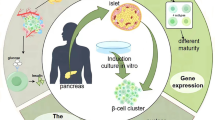Summary
Rat submandibular salivary gland acinar cells were transfected by CaPO4 precipitation using a plasmid containing a replication-defective simian virus (SV40) genome. Out of 27 clonal cell lines, two were shown to have moderate to high levels of cytodifferentiation and salivary gland acinar cell function. Functional studies with the two cell lines indicated that the β-adrenergic agonist, isoproterenol, vasoactive intestinal peptide, and prostaglandin E1 were effective activators of intracellular cyclic AMP production. Epinephrine, norepinephrine, phenylephrine, acetylcholine, and P2U-purinoceptor agonists were effective in increasing inositol phosphate production and intracellular free calcium levels, whereas substance P was without effect. Utilizing indirect immunofluorescence analysis, both cell lines were shown to express glutamine/glutamic acid-rich proteins, a submandibular acinar cell specific secretory protein family. Electron microscopic evaluation documented the maintenance of tripartite junctional complexes, cellular polarization, and the presence of moderate amounts of secretory granules and rough endoplasmic reticulum. The two cell lines had doubling times of 25 h.
Similar content being viewed by others
References
Ball, W. D.; Redman, R. S. Two independently regulated secretory systems within the acini of the submandibular gland of the perinatal rat. Eur. J. Cell Biol. 33:112–122; 1984.
Boarder, M. R.; Weisman, G. A.; Turner, J. T., et al. G protein-coupled P2 purinoceptors: from molecular biology to functional responses. Trends Pharmacol. Sci. 16:133–139; 1995.
Dubyak, G. R.; El-Moatassim, C. Signal transduction via P2-purinergic receptors for extracellular ATP and other nucleotides. Am. J. Physiol. 265: C577-C606; 1993.
Engebrecht, J. A.; Brent, R. Minipreps of plasmid DNA. In: Ausubel, F. A.; Brent, R.; Kingston, R. E., et al., eds. Current protocols in molecular biology. New York: Greene Publishing and Wiley-Interscience; 1989:1.61–1.62.
Gluzman, Y.; Sambrook, J. F.; Frisque, R. J. Expression of early genes of origin-defective mutants of simian virus 40. Proc. Natl. Acad. Sci. USA 77:3898–3902; 1980.
Gruenert, D. C.; Basbaum, C. B.; Welsh, M. J., et al. Characterization of human tracheal epithelial cells transformed by an origin-defective simian virus 40. Proc. Natl. Acad. Sci. USA 85:5951–5955; 1988.
Grynkiewicz, G.; Poenie, M.; Tsien, R. Y. A new generation of Ca2+ indicators with greatly improved fluorescence properties. J. Biol. Chem. 260:3440–3450; 1985.
Humphreys-Beher, M. G. Control of cell growth and proliferation. In: Dobrosielski-Vergona, K., ed. Biology of salivary glands. Boca Raton, FL: CRC Press; 1993:239–262.
Martinez, J. R. Cellular mechanisms underlying the production of primary secretory fluid in salivary glands. Crit. Rev. Oral Biol. Med. 1:67–78; 1990.
Moreira, J. E.; Tabak, L. A.; Bedi, G. G., et al. Light and electron microscopic immunolocalization of rat submandibular gland mucin glycoprotein and glutamine/glutamic acid-rich proteins. J. Histochem. Cytochem. 37:515–528; 1989.
Parr, C. E.; Sullivan, D. M.; Paradiso, A. M., et al. Cloning and expression of a human P2U nucleotide receptor, a target for cystic fibrosis pharmacotherapy. Proc. Natl. Acad. Sci. USA 91:3275–3279; 1994.
Patton, L. L.; Wellner, R. B. Established salivary cell lines. In: Dobrosielski-Vergona, K., ed. Biology of the salivary glands. Boca Raton, FL: CRC Press; 1993:319–341.
Putney, J. W., Jr. Inositol lipids and cell stimulation in mammalian salivary gland. Cell Calcium 3:369–383; 1982.
Quissell, D. O.; Redman, R. S.; Barzen, K. A., et al. Effects of oxygen, insulin and glucagon concentration on rat submandibular acini in serum-free primary culture. In Vitro Cell. Dev. Biol. 24:734–742; 1994.
Quissell, D. O.; Redman, R. S.; Mark, M. R. Short-term primary culture of acinar-intercalated duct complexes from rat submandibular glands. In Vitro Cell. Dev. Biol. 22:469–480; 1986.
Quissell, D. O.; Watson, E.; Dowd, F. J. Signal transduction mechanisms involved in salivary gland regulated exocytosis. Crit. Rev. Oral Biol. Med. 3:83–107; 1992.
Redman, R. S. Myoepithelium of salivary glands. Microsc. Res. Tech. 27:25–45; 1994.
Redman, R. S.; Quissell, D. O. Isolation and maintenance of submandibular gland cells. In: Dobrosielski-Vergona, K., ed. Biology of the salivary glands. Boca Raton, FL: CRC Press; 1993:285–306.
Seidman, C. E.; Struhl, K. Introduction of plasmid DNA into cells. In: Ausubel, F. A.; Brent, R.; Kingston, R. E., et al., eds. Current protocols in molecular biology. New York: Green Publishing and Wiley-Interscience; 1989:1.8.2–1.8.3.
Shimizu, H.; Daly, J. W.; Creveling, C. R. A radioisotopic method for measuring the formation of adenosine 3′, 5′ cyclic monophosphate in incubated slices of brain. J. Neurochem. 16:1609–1669; 1969.
Streb, H.; Irvine, R. F.; Berridge, M., et al. Release of Ca2+ from a nonmitochondrial intracellular store in pancreatic acinar cells by inositol-1,4,5,-triphosphate. Nature 306:67–69; 1983.
Turner, J. T.; Yu, H. Identification of functional receptors for vasoactive intestinal peptide and neurotensin in the human submandibular gland duct cell line, HSG-PA. Regul. Pept. 36:173–182; 1991.
Wigler, M.; Silverstein, S.; Lee, L. S., et al. Transfer of purified herpes virus thymidine kinase gene to cultured mouse cells. Cell 11:223–232; 1977.
Yu, H.; Turner, J. T. Functional studies in the human submandibular duct cell line, HSG-PA, suggest a second salivary gland subtype for nucleotides. J. Pharmacol. Exp. Ther. 259:1344–1350; 1991.
Author information
Authors and Affiliations
Rights and permissions
About this article
Cite this article
Quissell, D.O., Barzen, K.A., Gruenert, D.C. et al. Development and characterization of SV40 immortalized rat submandibular acinar cell lines. In Vitro Cell.Dev.Biol.-Animal 33, 164–173 (1997). https://doi.org/10.1007/s11626-997-0137-8
Received:
Accepted:
Issue Date:
DOI: https://doi.org/10.1007/s11626-997-0137-8




